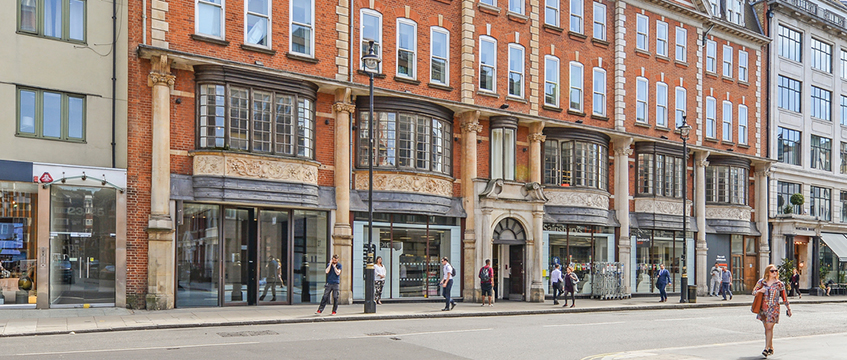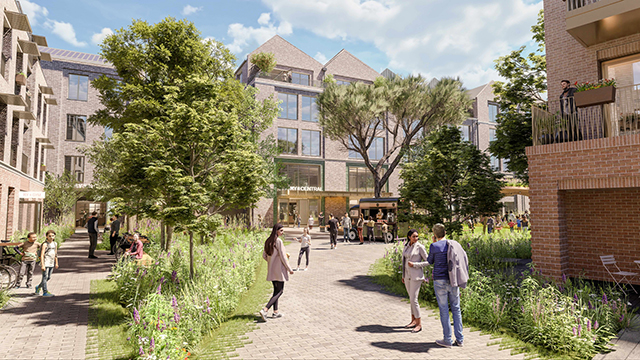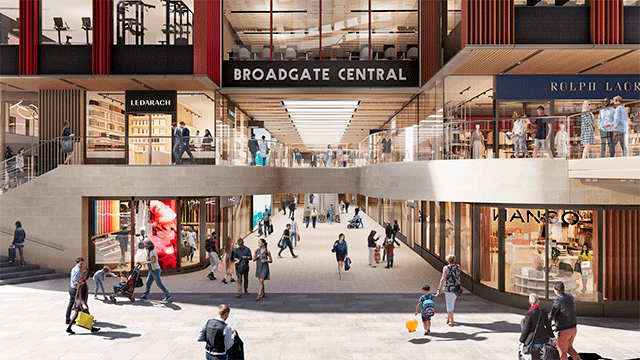The development arm of supermarket giant Tesco – Spenhill Regeneration – submitted a planning application last November for a mixed-use scheme that it promises will breathe new life into the north Kent town of Sittingbourne.
Proposals include a Tesco Extra store and 11 additional shops on the site of the former Sittingbourne industrial park. Improvements will be made to the existing Forum shopping centre, where space vacated by The Co-operative Food will be filled by a Tesco store.
The plans also include a bridge over a railway line, which will provide cyclists and pedestrians with access to Sittingbourne town centre, where Spenhill proposes to provide further retail, restaurants and a cinema. There is also potential for the development to incorporate office space, housing and a multistorey car park.
Tesco spokesman Jonathan Simpson insists that the scheme has genuine regeneration value. “We have been developing our plans for Sittingbourne for the past five years,” he says. “Residents want improved shopping and leisure facilities to revitalise the town centre and create a vibrant evening economy.”
As with many other major development schemes in recent years, progress has been slow. Tesco’s long-standing development agreement with Swale council expired in 2010, although the supermarket is hoping it will pip two other short-listed candidates to the post when a development partner is announced this month.
Railway track
It is understood that Spenhill is the only developer proposing to reconnect the north and south of the town, which is bisected by a railway track. Despite warnings from the Commission for Architecture and the Built Environment about the danger of supermarket-led regeneration around the country, willing private sector partners with cash to spend are few and far between.
John Wright, Swale council’s executive portfolio holder for regeneration, insists the council is willing to talk to any developer ready to invest in infrastructure, public realm and commercial space.
“We are particularly keen to improve Sittingbourne’s retail offer,” he says. “Studies show around 70% of comparative spend is lost to other locations, such as Bluewater shopping centre. We have to give people a reason to spend their money in the town.”
Although rival supermarket chain Morrisons is also looking to open a store in Sittingbourne, on the site of a former paper mill, Wright insists there is capacity for additional supermarket provision.
“But who’s to say Tesco won’t just build its own store then abandon the scheme?” asks Henry Holdstock, partner at local agent George Webb Finn. “I don’t know how the council is going to tie Tesco down to spend money on the bridge and improvements to the town centre.”
He adds: “You have to question whether this amount of new space is sustainable. If all we end up with is another supermarket, trade will simply be diverted from the town centre.”
Phasing issues
Spenhill’s response is that it is committed to delivering the scheme in its entirety, and will work closely with the council in the coming months on phasing issues.
In Sittingbourne, a nationwide debate about the merits of supermarket-led regeneration is being played out. The plans have their critics, but some believe that, as long as certain stipulations are met, a developer with cash resources, which is willing to build should to be embraced by the council.
Nick Smith, chair of Sittingbourne Retailers’ Association, says: “If Tesco can improve footfall and get more people spending their money in the town, it can only be a good thing. As long as the council is strict in insisting investment is made at both ends of the town, Tesco’s proposals should be warmly welcomed.”
Last chance saloon for Gravesend scheme
Developer Edinburgh House Estates has appealed to the secretary of state to salvage its £120m proposals for Gravesend’s Heritage Quarter. The scheme – for 120,000 sq ft of retail, 30,000 sq ft of leisure, around 400 flats, a 51-bedroom hotel and 5,000 sq ft of offices – was rejected by the council last September.
Plans were submitted in 2008, and Edinburgh House had already dropped proposals for a 32-storey residential tower.
Tony Quayle, Edinburgh House’s managing director, says: “This latest delay really puts Gravesend’s regeneration under threat. The scheme would have created 1,000 jobs, and was designed to enhance the historic character of the area.”
The council rejected the scheme on grounds including height, bulk and massing, with many objectors complaining that the development was not in keeping with the surrounding architecture.
Jonathan Clay, chair of civic society Urban Gravesham, says: “This area requires sensitive development, not the heavy foot of a large, misconceived scheme such as this.”
Raymond Amosso of local agent Caxtons Commercial, agrees. “The town doesn’t need any more apartments, and it would struggle to fill the office space without a prelet,” he says. “It’s true that we need more modern shops, but there is too much secondary stock, some of which could surely be reconfigured.”
The town is struggling to attract major retailers, and rents languish at £40-£50 per sq ft. For that reason, Sue Sangha, partner at local agent Maltbys, is in favour. “Retail here is dead,” she says. “We’ve lost so much spend to the likes of Bluewater. These plans are just what we need to draw people back into the town.”
The council’s leader, Mike Snelling, says it is critical to regenerate the Heritage Quarter. “There is a danger that Gravesend could fall into a spiral of decline unless there is significant investment in the town centre,” he says.
But even if Edinburgh House’s appeal is successful, construction is likely to be delayed until early 2012. Quayle says: “We’re fully committed to the scheme, but have already spent £4m to get this far. We just have to hope that, if we are successful, market conditions will be in our favour.”










